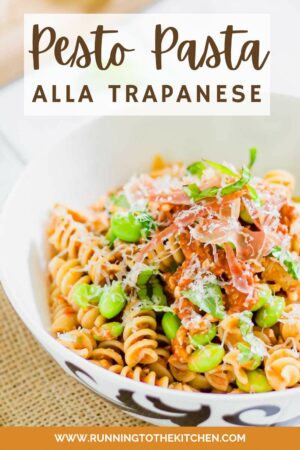This Pesto alla Trapanese is a delightfully fresh take on pesto made with fresh tomatoes, almonds, pepperoncini and a handful of other simple ingredients. It’s quickly processed into a refreshing summer sauce and tossed with pasta for an easy meal.

We all think of pesto as a bright green sauce typically made with basil that lusciously coats pasta. Sure, we know that making it with other greens such as arugula, ramps and even radish greens is possible too, but I don’t think many of us realize the extent to which pesto can be customized.
This Pesto all Trapanese recipe is the perfect example of that.
Pesto comes from the word pestar in Italian which means to crush. Simply put, making pesto just means crushing ingredients using a mortar and pestle. There’s nothing that includes basil, parmesan and pine nuts in that definition. It just so happens that the northern Italian recipe originating from the Genoa region of the country is what we all associate with a traditional pesto recipe.
Trapanese pesto sauce comes from Sicily, geographically almost as far away from Genoa as you can get, and that distance is reflected in the unique ingredients it uses to make the pesto of its region.
To me, Pesto all Trapanese is a bit reminiscent of penne a la vodka. Except, instead of heavy cream making it the kind of sauce that might give you stomachache if you eat too much, it’s bright and light like a true pesto sauce would be.
With simple ingredients like ripe tomatoes, almonds and pepperoncini for a touch of heat, it shines as a wonderful summer alternative to green pesto.

What is Pesto alla Trapanese (Sicilian Pesto)?
Pesto alla Trapanese, also known as Pesto alla Siciliana, is a traditional Sicilian dish originating from the coastal town of Trapani in Italy. The recipe’s origins are deeply rooted in the maritime history of Sicily, as it is believed that the dish was created by sailors who brought back new flavors from their travels to the ports of Trapani.
The distinct flavor of Pesto alla Trapanese is achieved through the combination of fresh tomatoes, almonds, basil and peperoncino, giving it a unique taste that sets it apart from other pesto variations. The use of almonds in place of pine nuts, which are more commonly found in Genovese pesto, adds a delightful nuttiness to the sauce.
What makes Pesto alla Trapanese truly special is its adaptability, as it can be served in various ways such as tossed with pasta, spread on bruschetta or used as a marinade. Its vibrant flavors make it a must-try for anyone looking to expand their horizons on Italian cuisine.
Why You’ll Love This Pesto alla Trapanese Recipe
- Vibrant Flavors: Pesto alla Trapanese is bursting with the fresh, vibrant flavors of tomatoes, basil, and almonds, making it a unique variation from traditional pesto recipes.
- Versatility: This sauce can be used in various ways, whether it’s tossed with pasta, spread on bruschetta, or used as a marinade, making it a versatile addition to your culinary repertoire.
- Rich history: The recipe’s origins are deeply rooted in the maritime history of Sicily, adding a layer of cultural and historical significance to the dish.
- Unique ingredients: The use of almonds instead of pine nuts and the addition of peperoncino give Trapanese pesto a unique and delightful nuttiness.

Ingredients to Make Trapanese Pesto
- Cherry tomatoes: These provide a burst of sweet, juicy flavor to the pesto.
- Blanched almonds: Lightly toasted for a nutty, crunchy texture in the sauce.
- Cloves garlic: Adds a pungent, aromatic flavor to the pesto.
- Fresh basil leaves: Infuse the pesto with a fresh, aromatic herbal note.
- Pepperoncini: For a hint of heat and tanginess in the pesto.
- Parmesan or Pecorino Romano cheese: Brings a savory, salty richness to the pesto.
- Extra-virgin olive oil: Provides a smooth, fruity richness to the pesto.
- Salt and black pepper: Enhances the overall flavor of the pesto.
Optional Add-ons and Substitutes:
- Cheeses: Pecorino Romano is a tangy, salty alternative to Parmesan used in many classic Italian recipes like cacio e pepe that can replace the Parmigiano-Reggiano.
- Mint leaves: Adds a refreshing, cooling note to the pesto.
- Busiate pasta: A traditional Sicilian pasta that pairs perfectly with Trapanese pesto. Gemelli is a similar shaped pasta and typically easier to source.
- Pine nuts: Offers a buttery, delicate nuttiness to the sauce.
- Grape tomatoes: Can be used instead of cherry tomatoes for a slightly different flavor.
- Kosher salt: A coarser, flakier salt that can be used to season the pesto.
- Sicilian almonds: Adds an authentic touch to the pesto’s flavor and texture.
- Pistachios: Provides a unique, slightly sweet flavor and a vibrant green color to the pesto.
How to Make Pesto alla Trapanese?
Combine the tomatoes, almonds, garlic, basil, pepperoncini, crushed red pepper, cheese and a good pinch of salt and pepper in a food processor or blender. Pulse the ingredients a few times until finely chopped. With the motor running, add the oil in a thin stream until the mixture is well combined. Remember to taste the pesto and adjust the seasoning if needed.
Meanwhile, cook the pasta in a large pot of salted water until it reaches an al dente texture. Once cooked, drain the pasta and return it to the pot. Pour the pesto over the pasta and toss to combine. You have the option to use only as much pesto as you prefer. Any remaining pesto can be stored in a sealed container in the fridge for up to a week.
Serve the pasta with an additional sprinkle of cheese and basil as desired.

Recipe Tips
If you prefer a coarser texture to your pesto, a mortar and pestle can be used to blend the ingredients. Simply crush and grind the mixture to achieve the desired consistency before following the remaining instructions.
Additionally, you can add some reserved pasta water to loosen the sauce if needed.
How to Serve Trapanese Pesto Pasta?
You can enjoy Trapanese pesto pasta hot or cold in pasta salad form. In Sicilian tradition, it’s often topped with toasted breadcrumbs for extra flavor and texture.
What is the difference between pesto alla Genovese and Trapanese?
The main difference lies in the ingredients. Pesto alla Genovese typically contains basil, pine nuts, garlic and Parmigiano-Reggiano. Pesto alla Trapanese, on the other hand, uses tomatoes, almonds, garlic, basil and pecorino cheese. Additionally, Pesto alla Genovese is from the Liguria region, and Pesto alla Trapanese is from the coastal town of Trapani in Sicily.
More pesto recipes to try:
Creamy garlic scape pesto — This seasonal pesto recipe is the perfect answer to the late spring and early summer bounty of garlic scapes. Combined with ricotta, it makes a wonderfully creamy pasta sauce and unique pesto recipe.
Zucchini pesto — Another way to take advantage of summer’s bounty by turning an abundant vegetable into a delicious pasta sauce.
Pesto Pasta alla Trapanese

Ingredients
- 2 cups cherry tomatoes
- 1/3 cup almonds, lightly toasted
- 2 cloves garlic
- 1/4 cup packed basil leaves
- 1 pepperoncini, stem removed
- 1 pinch crushed red pepper flakes
- 1/4 cup freshly grated Pecorino Romano cheese
- 3 tablespoons extra-virgin olive oil
- 1 pound rotini pasta, or other similar shape
- coarse salt and freshly ground pepper
Instructions
- In a food processor, combine the tomatoes, almonds, garlic, basil, pepper, crushed red pepper, Pecorino Romano cheese and a hearty pinch of salt and pepper. Pulse a few times then scrape down the sides. With the food processor running, slowly add the olive oil. Season to taste with salt and pepper.
- Meanwhile, cook the pasta in a large pot of salted water until al dente. Drain and return to the pot.
- Pour the pesto over the pasta and toss to combine until all the pasta is coated. You may not have to use all the pesto.
- Serve with with more freshly grated parmesan cheese and thinly sliced basil!
Notes
Nutrition
Nutrition information is automatically calculated, so should only be used as an approximation.
Gina Matsoukas is an AP syndicated writer. She is the founder, photographer and recipe developer of Running to the Kitchen — a food website focused on providing healthy, wholesome recipes using fresh and seasonal ingredients. Her work has been featured in numerous media outlets both digital and print, including MSN, Huffington post, Buzzfeed, Women’s Health and Food Network.










OK, You’ve convinced me. I MUST buy a real “big girl” food processor… ASAP! All that amazing stuff into the sauce?!?! I went to Bev’s site then came back as you instructed :) This looks amazing!
I actually did this in my mini food processor! I only made enough sauce for 1 so it worked out fine. Sometimes the thought of cleaning the big one is more of a deterrent than using the crappy little one. ;)
Hey! I nominated you for the Liebster Blog Award. Check out the post here: https://sarasmiles.com/2012/08/04/the-liebster-award-11-things-you-might-not-have-known/
GIMME! i’ve been dying to try that pesto since seeing it on bev’s blog too – nosedive sounds appropriate!
I have forgotten about summer pastas and am even out of pasta! Thanks for the reminder that summer pastas are awesome. Man, this looks so good.
How did your BlogHer conference go by the way? Hope you had fun! :)
Giiiiiirl LOOK at that prosciutto on top. I’m dying. That looks insane. I love it.
I’m so glad you dug it! xo!
I saw this on Bev’s site and have been meaning to make it. I love your additions too.
Bev always has great dinners and savory options – you two are sort of foodie + photography twins. I see lots of parallels. These pics are great. The use of textures, the angles with the fork, napkin, cutting board, and underlying white surface – love the opening pic!
This is wonderful of you to have from bookmark to blog! I just love that you do that! This dish does look quite amazing! Bev Cooks has some awesome recipes!! Have a great weekend!!
I’m such a sucker for pasta, but I never allow myself to make it with a heavy cream. It can be just as good without all of those extra calories. I love that you put procsuitto on top. I bet those flavors together were amazing!
I think I would inhale that! It looks delicious.